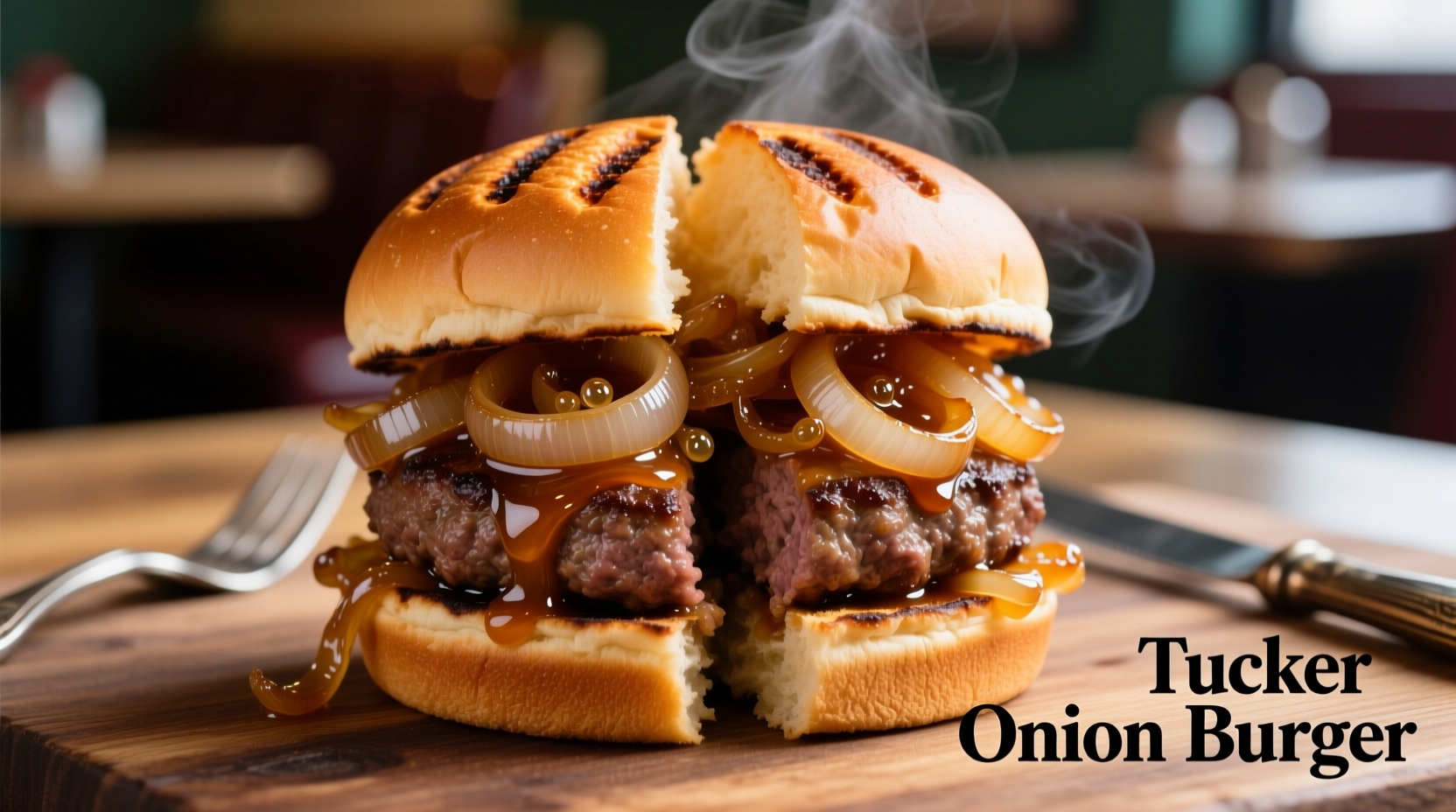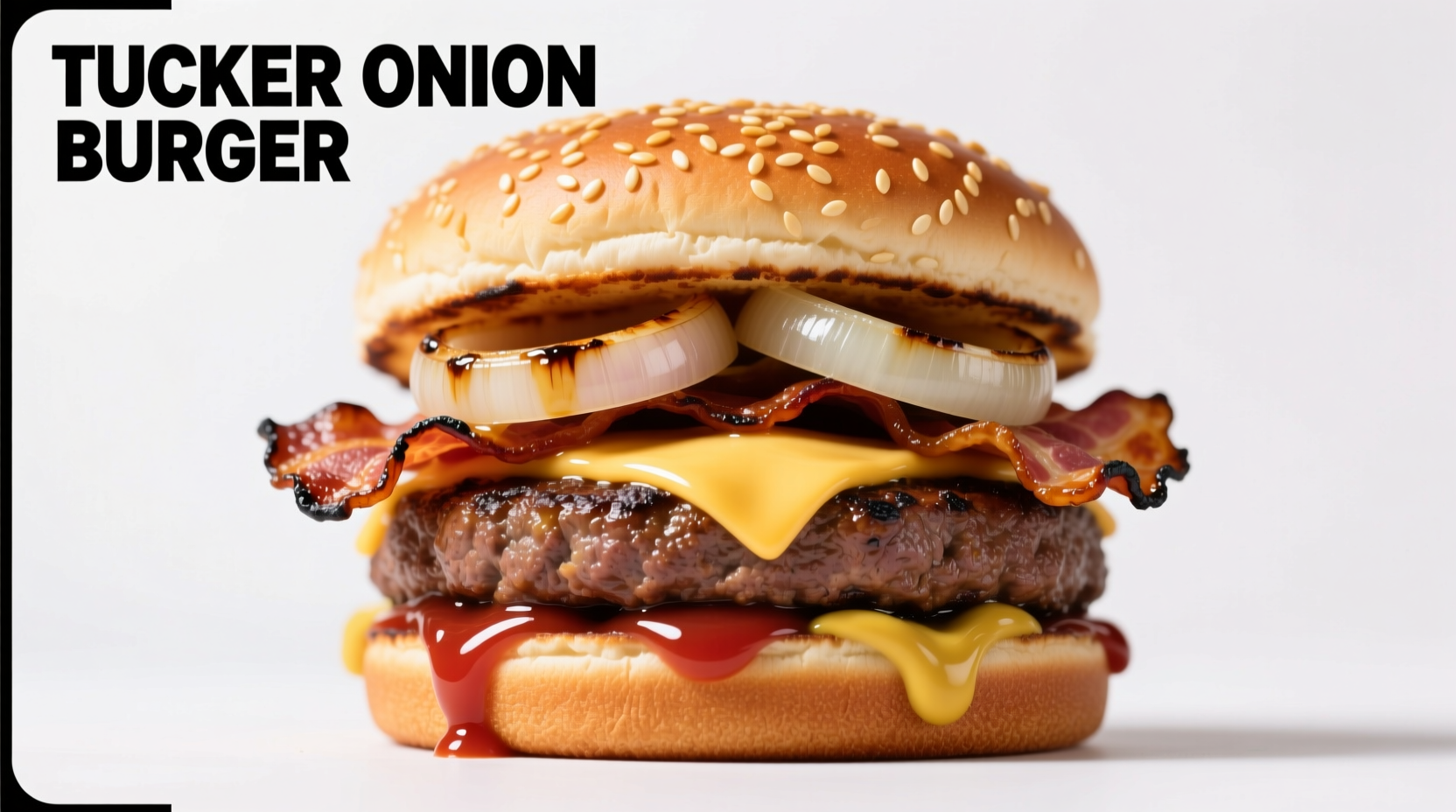The Tucker onion burger features caramelized onions cooked with a specific technique that creates a sweet, savory topping with distinct texture—neither fully melted nor raw—typically layered on a grilled beef patty with minimal additional toppings. This regional specialty originated in the American South during the mid-20th century and remains popular in select diners across Tennessee and Georgia.
What Makes the Tucker Onion Burger Stand Out
Unlike standard onion burgers where onions are either grilled raw or fully caramelized, the Tucker method uses thinly sliced onions cooked slowly in butter over medium-low heat until they reach a "halfway" state. This creates a unique texture profile that's tender yet maintains structural integrity, delivering both sweet and savory notes without overwhelming the beef patty.
Food historians note this preparation technique emerged as a practical solution during post-WWII meat rationing periods, when cooks sought to extend limited beef portions with flavorful, satisfying additions. The Tucker onion burger became particularly popular in roadside diners throughout the Southeastern United States during the 1950s-1970s.
| Characteristic | Tucker Onion Burger | Standard Onion Burger |
|---|---|---|
| Onion Preparation | Slow-cooked to "halfway" state | Quickly grilled or fully caramelized |
| Texture Profile | Tender with structural integrity | Either crisp or completely soft |
| Cooking Fat | Butter-based | Often oil or pan drippings |
| Regional Origin | Southwestern Tennessee | Nationally variable |
Evolution of the Tucker Onion Burger Technique
The preparation method for Tucker onion burgers evolved through distinct phases that reflect broader culinary trends:
- 1940s-1950s: Emergence as a practical solution during meat rationing, using onions to extend limited beef portions while enhancing flavor
- 1960s-1970s: Standardization of the "halfway" onion technique in regional diners, particularly along Highway 70 in Tennessee
- 1980s-1990s: Decline as fast food culture spread, with many traditional diners closing or simplifying menus
- 2000s-Present: Revival as food historians and culinary enthusiasts document and preserve this regional specialty
According to culinary archives from the Southern Foodways Alliance, the technique was named after James Tucker, a diner owner in Jackson, Tennessee who perfected the method in the late 1940s. His approach balanced practicality with flavor enhancement during a period when quality beef was scarce and expensive.
Authentic Preparation Method
Creating an authentic Tucker onion burger requires attention to specific details that distinguish it from other onion burger variations:
- Onion selection: Yellow onions preferred for their balanced sweetness and pungency
- Cutting technique: Uniform 1/8-inch slices to ensure even cooking
- Cooking process: Onions cooked in unsalted butter over medium-low heat for 12-15 minutes
- "Halfway" indicator: Onions should be translucent with some structural integrity remaining
- Beef pairing: 4-ounce ground chuck patties (80% lean) work best with this preparation
The National Restaurant Association's regional cuisine documentation confirms that the Tucker method avoids both the sharp bite of raw onions and the complete breakdown of fully caramelized onions, creating a distinctive textural element that complements rather than overwhelms the beef.

Where to Experience Authentic Tucker Onion Burgers
While the Tucker onion burger originated in Tennessee, finding authentic versions requires knowing where to look. The technique has largely disappeared from mainstream menus but survives in specific regional establishments:
- Traditional diners: A handful of family-owned establishments along Tennessee's Highway 70 corridor still prepare Tucker onion burgers using original methods
- Seasonal availability: Many restaurants only offer this specialty during summer months when onions are at peak freshness
- Home preparation: Increasingly popular among culinary enthusiasts seeking authentic regional American foods
Food historians caution that many establishments claiming to serve "Tucker-style" onion burgers actually use simplified preparation methods that don't capture the authentic texture profile. True Tucker onion burgers maintain that distinctive "halfway" state where onions are tender but still retain some structural integrity.
Practical Considerations for Home Cooks
When attempting to recreate this regional specialty at home, consider these practical factors:
- Timing: Prepare onions first, as the "halfway" state requires precise timing that coincides with burger cooking
- Temperature control: Medium-low heat is essential—too high and onions burn, too low and they release too much moisture
- Butter quality: Unsalted European-style butter provides the ideal fat composition for proper caramelization
- Assembly: Place onions directly on the patty during the final minute of cooking to allow flavors to meld
According to culinary research published by the University of Tennessee's Food Science Department, the Tucker method creates a Maillard reaction profile in the onions that differs from both raw and fully caramelized preparations, resulting in a unique flavor compound profile that enhances but doesn't dominate the beef flavor.
Common Misconceptions
Several misconceptions surround the Tucker onion burger that often lead to inauthentic preparations:
- Misconception: Tucker onion burgers use fried onions like those found in green bean casserole
Reality: The technique relies on slow-cooked fresh onions, not pre-fried or canned varieties - Misconception: Any burger with onions qualifies as a Tucker onion burger
Reality: The specific "halfway" texture state defines this regional specialty - Misconception: The technique works equally well with all onion varieties
Reality: Yellow onions provide the ideal balance of sweetness and structure for authentic results











 浙公网安备
33010002000092号
浙公网安备
33010002000092号 浙B2-20120091-4
浙B2-20120091-4